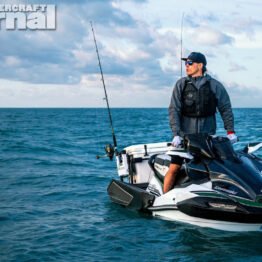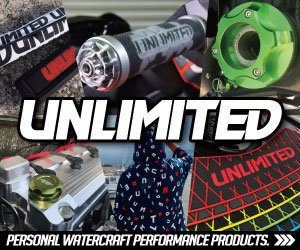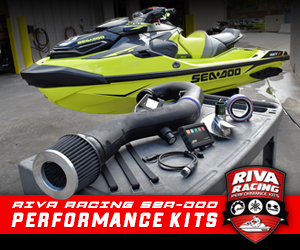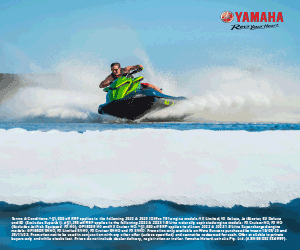
So here we are. It’s 2018 and the new and pre-owned personal watercraft market hasn’t been as strong in 11 years. PWC sales are seeing huge increases: Yamaha Motor Corporation, USA experienced a 14-percent growth over last year’s sales, Sea-Doo picked up 6-percent in sales, Kawasaki nabbed an impressive 11-percent (thanks in no small measure to the introduction of its 4-stroke SX-R) and that’s good news for everybody. For 2017, total new vehicle sales totaled at 67,500-plus units, which during the past 12 months, 88 million Americans took to the water, equating to a growth explosion 3-to-4 times greater than previous projections.
Of that growth in the boating market, the personal watercraft industry leapt up an incredible 11-percent in new unit sales – Yamaha reported an impressive 49-percent of new vehicle sales went to first-time buyers (Kawasaki also reported a strong 38-percent in first-time buyer sales). That is a percentage unmatched by any powersport market, be it motorcycles, snowmobiles or otherwise. So what can be done with all of this good news?
Waaay back in 2014, The Watercraft Journal tossed out a very special edition of “Vicious Rumors and Vile Gossip” that not necessarily predicted three runabouts (one from each manufacturer) that were destined to be made, but rather suggested that the trio could easily be offered by each respective OE without much in the way of development costs and manufacturing tooling. In fact, the financial impact to each manufacturer was so minimal that we wagered that little to zero actual cost would be levied in two particular examples: the Kawasaki Ultra LX SE JetSki and the Sea-Doo GTI Limited 215.
Of course, the third suggestion, the Yamaha VXR SVHO later became the GP1800, that is, after Yamaha completely revamped the VX platform literally later that same year as our article (with the GP1800 showing up two years later). Yes, as you’ll see below, we’re going to rehash one suggestion – that is with a few tweaks – and massage our second suggestion for the industry’s leader. Next, we’ve got an all-new idea that we think is a no-brainer for most, particularly in the targeted demographic for which Yamaha is aiming to corner.
Again, these are three suggestions based on absolute minimal cost to the manufacturer that will better cater to each manufacturer’s gaps in their particular product line. This isn’t revolutionary stuff here, folks; just ideas that will appeal to certain would-be buyers and nudges to each manufacturer where they can “flesh out” their product lineup.
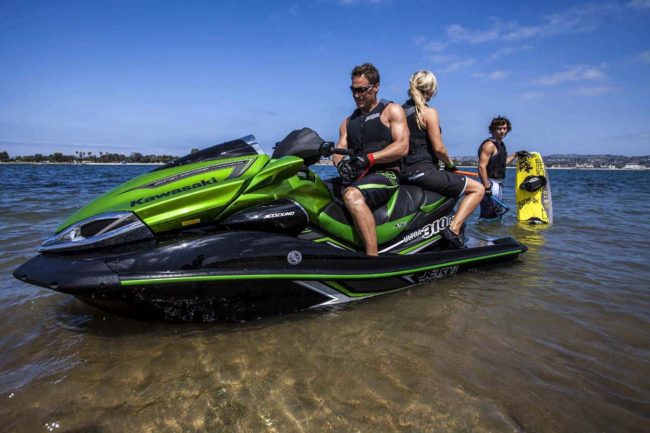
Kawasaki Ultra LX SE (Special Edition)
One of the most reliable market segments in personal watercraft is the Recreational Touring segment. This demographic trends older, focuses heavier on comfort, amenities and fuel mileage. While full-sized, 3-passenger entries like Yamaha’s FX HO Cruiser and Sea-Doo’s GTX Limited 155 flourish in this segment, Kawasaki truly has little to compete. The naturally-aspirated Ultra LX is bereft of anything resembling an added feature; there’s no Cruise Control, No Wake mode, easily-accessed Economy mode or brakes. Moreover, the LX doesn’t come with any accessories like the other two (ie. a ski cover, dock bumpers, dry bag, etc.). Rather, there’s little “LX” about the LX at all.
Borrowing almost everything from the $17,999 MSRP supercharged Ultra 310LX, the proposed LX SE would benefit from the incorporation of the 310-horsepower engine’s advanced fly-by-wire throttle and ignition system but without the TVS roots-style Eaton supercharger and massive intercooler. Rather, the 1496cc 4-cylinder, four-stroke would breathe in atmosphere naturally, and gain electronic trim control, cruise, and Eco mode. Other carry-overs include Kawasaki’s heat-resistant, two-toned, high-bolstered bench seat and of course, the industry’s first factory-installed onboard sound system, Jetsounds. Toss in a JetSki cover, a dock line rope and a dry bag, and you’ve got a pretty nice touring package.
This all teeters on whether Kawasaki is still committed to building its PWC line. The STX-15F is now 15-years-old, and the Ultras’ deck has been the same since 2007 (with slight modifications to the hood and cowling in 2010). Tweaks to the hull have occurred twice, once in 2008 and again in 2010, with powertrain improvements happening a handful of times, most notably the jumps in performance from 250 to 260, the leap to 300 in 2010, and the last, being an efficiency upgrade in 2014, picking up an added 10-ponies, totaling 310. The SX-R was heavily anticipated, but was mainly stitched from parts-bin leftovers. Certainly brakes will raise the brand to a level comparable to its competitors, and hopefully, a naturally-aspirated tourer will help expand its reach to a broader audience.
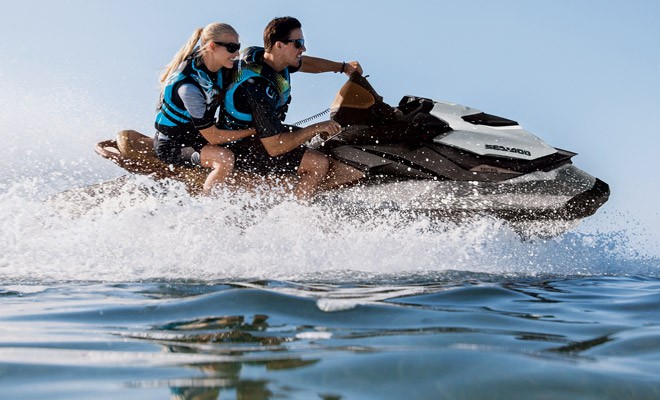
Sea-Doo GTI Limited 230 & GTR Limited 230
There’s no other way to look at it; Sea-Doo poured all of the spotlight on its new ST3 platform runabouts for 2018. Almost everything else in the brand’s massive 17-unit lineup took a backseat to the new racy RXP-inspired hull, centralized storage system, and newfound stability. Silly ad spots with hulking weightlifters balancing on the rear deck replaced youthful riders zipping carelessly aboard iridescent Sparks or families sunbathing on the sand while their new purchase glimmers on the shore. One vehicle that went almost entirely unnoticed was the 2018 GTI Limited 155. Apart from receiving the same Liquid Grey Metallic and Equestrian Brown livery as its full-sized GTX Limited siblings, everything else remains almost entirely the same.
Common knowledge to most Sea-Doo enthusiasts, the luxuriated GTI shares the same hull and underpinnings as the GTR 230 and even the GTR-X 230. These two machines enjoy the benefit of Sea-Doo’s supercharged ACE 1500 four-stroke 3-cylinder producing a stout 230-horsepower, as well as quick-reacting VTS (Variable Trim System), a sporty seat and not much else. Taking a cue from the brand’s top-of-the-line GTX Limited 300 unit, a smaller, sportier and heavily-adorned GTI Limited could be offered; in fact, two of them, we surmise. The first of course, would be almost indistinguishable from the GTI Limited 155, save for the “230” call-outs on the sides, similar to the minimalist distinctions between the 230 and 300-horsepower units on the larger platform.
We also think that a GTR Limited 230 would be equally doable, differentiated by a silver-painted GTR-X top deck and brown seats and inserts. And with all Limited packages, would come with Sea-Doo’s veritable treasure trove of accessories equipped on all Limited machines. These offerings would not only dramatically expand the brand’s Limited package offerings, but allow the more selective performance enthusiast two new options from which to choose from. Even if produced in small numbers, the rare luxury performance units could give a leg-up to those choosing between a 230-horsepower Sea-Doo and a GP1800 Yamaha.

Yamaha FX HO Limited
Frankly, we’re surprised we have to even write this idea down, because it would’ve seemed like a “no brainer” for Yamaha a year or two ago. It’s no secret that all of us at The Watercraft Journal absolutely love Yamaha’s “family fun starter pack” package – the Limited – ever since the day it was first offered on the VX. The Limited package takes a standard WaveRunner and tosses in some unique branding, chrome lettered emblems, a unique color arrangement, a 12-volt socket in the glove box, a phone case, storage bag, tow rope, 1-passenger raft, an inflator (to fill said raft) and a ski cover. For 2016, Yamaha added the Limited package to the top-of-the-line FX SVHO Cruiser, which is great, but we propose a naturally-aspirated option for next year: the Yamaha FX HO Limited.
As stated previously, the FX HO is an incredibly popular machine (both in standard and Cruiser iterations). Enthusiasts of the touring model have even voiced interest in the Limited package just for the paint scheme and emblems alone. Moreover, the addition of the Limited package to $13,299-priced FX HO would be a far easier pill to swallow than the $16,899 FX SVHO Limited MSRP. There are certainly families looking for both a fuel-efficient 3-seater runabout and all of the amenities that the Limited package has to offer, so marrying the two is clearly a smart way to move both accessories and yet another new vehicle unit. Again, why we have to spell this out baffles us.
So, there you have it. A brief list of three machines that could be produced by each respective manufacturer with almost no cost in development or tooling – that is, beside the price of some new paint and decals. We tried to include solid reasoning behind each offering as well as how each could be executed. Certainly, these are ideas that have been bandied about behind closed doors in conference rooms by people who make much more money than we. Nevertheless, we’re pretty confident that one or more of these will come to fruition, if not by our suggestion or public demand.







